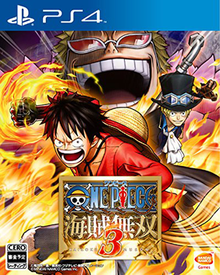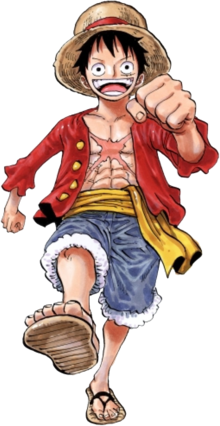
Monkey D. Luffy, also known as "Straw Hat" Luffy, is a fictional character and the protagonist of the One Piece manga series, created by Eiichiro Oda. Luffy made his debut as a young boy who acquires the properties of rubber after accidentally eating one of the Devil Fruits that belonged to "Red Hair" Shanks.
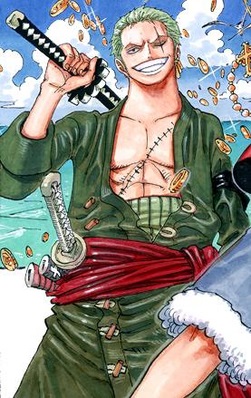
Roronoa Zoro, also known as "Pirate Hunter" Zoro, is a fictional character created by Japanese manga artist Eiichiro Oda who appears in the manga series and media franchise One Piece. He first appeared in the third chapter of the One Piece manga, published in the manga magazine Weekly Shōnen Jump in 1997. Zoro is the first crewmate to join Monkey D. Luffy to be part of his crew of pirates, after he is rescued by Luffy from execution. Zoro is a highly skilled swordsman and serves as the crew's combatant, though he possesses an extremely poor sense of direction which recurs as a running gag throughout the series.

Usopp, also known by his monikers Sniper King and "God" Usopp, is a fictional character in the One Piece franchise created by Eiichiro Oda. He serves as the sniper of the Straw Hat Pirates.
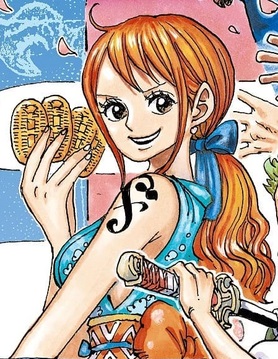
Nami, also known as "Cat Burglar" Nami, is a fictional character in the One Piece franchise created by Eiichiro Oda. She is based on Ann and Silk, two characters from Oda's previous manga Romance Dawn. She is introduced as a thief and pickpocket who possesses cartographical, meteorological, and navigational skills. At first, she is a subordinate of the fishman Arlong, but she is eventually freed of this service and permanently joins Monkey D. Luffy.

One Piece: Grand Battle is a fighting game made in Japan based on the anime and manga series One Piece. It is the fourth and final game in One Piece's Grand Battle series and the nineteenth One Piece video game released. The game was released in Japan as One Piece: Grand Battle Rush. The English version uses the intro from the TV series.
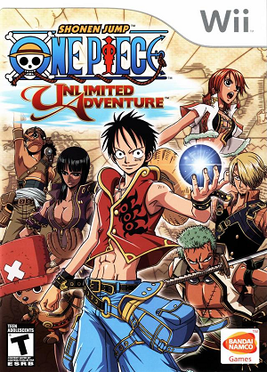
One Piece: Unlimited Adventure is a video game for the Nintendo Wii based on the manga and anime series One Piece by Eiichiro Oda, released in Japan on April 26, 2007 and in North America on January 22, 2008. The NTSC (American) version of the game uses the FUNimation voice actors exclusively.

One Piece: Grand Battle! 2 is a Japan-exclusive fighting game for the PlayStation developed by Ganbarion and published by Bandai in 2002. It is the second game in the One Piece: Grand Battle! series and the seventh game to be based on the One Piece manga and anime. Similar to the first game, this game uses the song "We Are!" from the One Piece anime, but with different lyrics, which is known as "We Are! Super-EX ver.".

One Piece Film: Strong World is a 2009 anime fantasy action adventure film directed by Munehisa Sakai and written by Hirohiko Kamisaka. It is the tenth feature film based on the shōnen manga series One Piece by Eiichiro Oda. The film features Naoto Takenaka and Scott McNeil as Shiki, the evil captain of his crew who kidnaps Nami to force her to join his crew and intends to conquer the East Blue. Monkey D. Luffy and his crew must stop Shiki from carrying out his plans.

Samurai Warriors: Chronicles is a hack and slash video game developed by Omega Force and published by Tecmo Koei for the Nintendo 3DS. It was released as a launch title in Japan on February 26, 2011, in Europe on March 25, 2011, in North America on March 27, 2011 and Australia on March 31, 2011.
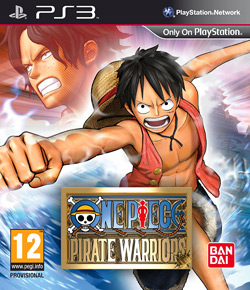
One Piece: Pirate Warriors is an action video game developed by Omega Force and published by Bandai Namco Games for PlayStation 3. It was released on March 1, 2012, in Japan, September 21, 2012, in Europe and September 25, 2012, in North America. The game was developed in commemoration of the 15th anniversary of the One Piece manga and anime franchise by Eiichiro Oda. Pirate Warriors was also the first title in the One Piece video game franchise which was released on a PlayStation system since One Piece: Grand Adventure in 2006.

One Piece: Pirate Warriors 2 is an action video game developed by Omega Force and published by Bandai Namco Games for PlayStation 3 and PlayStation Vita. It is the sequel to One Piece: Pirate Warriors. Due to the success of the first game, the sequel was released the year following. It was released in Japan on March 20, 2013, Europe on August 30, 2013, and in the U.S. on September 3, 2013.
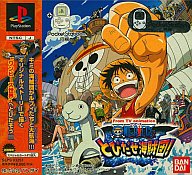
From TV animation - One Piece: Set Sail Pirate Crew! is a Japan-exclusive role-playing game published by Bandai for the PlayStation. It is the fourth game to be based on the One Piece manga and anime. This game's introduction uses the theme song Believe from the One Piece Anime.

From TV Animation - One Piece: Grand Battle! is a Japanese fighting video game developed by Ganbarion and published by Bandai. It is the first game in the One Piece: Grand Battle series and the second game to be based on the One Piece manga and anime. This game's introduction uses the theme song We Are! from the One Piece anime.

One Piece: Unlimited World Red is an action-adventure video game based on the famous One Piece manga and anime. This is the thirty-sixth video game based on the series, and the fifth title in the Unlimited sub-series. It was released for the Nintendo 3DS in Japan on November 21, 2013, and released for additional platforms and in more regions the following year. On March 12, 2014, the game was confirmed to be releasing in North America, Europe, and Japan in 2014 on PlayStation 3, PlayStation Vita, and Wii U. The Wii U version does not have a physical retail release in North America and Australia. Whilst other versions were released by July 8, 2014, in North America, the PlayStation Vita version was released in the region on July 14, 2014, and its limited retail release was sold exclusively via GameStop stores.

Dragon Quest Heroes: The World Tree's Woe and the Blight Below is a hack and slash game developed by Omega Force and published by Square Enix. It was released for PlayStation 3 and PlayStation 4 in Japan in February 2015, and in North America, Australia and Europe only for PlayStation 4 in October 2015. It was later released for Microsoft Windows in December 2015. The game received generally positive reviews, with a sequel Dragon Quest Heroes II being released in Japan during May 2016. Dragon Quest Heroes would later be released with the sequel in a compilation for Nintendo Switch in Japan.

Phantom Breaker: Battle Grounds is a beat 'em up developed and published by Mages under the 5pb. brand, and originally released on February 27, 2013 for the Xbox 360. it is a spin-off of the fighting game Phantom Breaker.
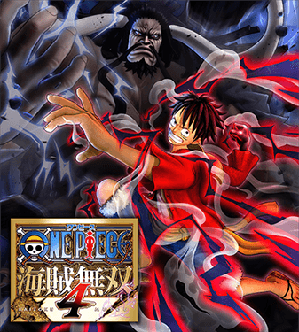
One Piece: Pirate Warriors 4 is an action-adventure video game developed by Omega Force and published by Bandai Namco Entertainment for Nintendo Switch, PlayStation 4, Windows, and Xbox One. It is the fourth installment in Pirate Warriors video-game series, based on the One Piece franchise. It is a sequel to the 2015 game One Piece: Pirate Warriors 3. It was released on March 27, 2020.

One Piece: Pirate Warriors also known in Japan as One Piece: Kaizoku Musou, is a series of action-adventure video games developed by Omega Force and published by Bandai Namco Entertainment. It is based on the One Piece manga and anime franchise by Eiichiro Oda. It is the most successful One Piece video game series, with over 7 million copies sold.
One Piece is a fantasy adventure television series developed by Matt Owens and Steven Maeda for Netflix. The series is a live-action adaptation of the manga series of the same name by Eiichiro Oda, who served as a major creative consultant on the show. It is produced by Kaji Productions and Shueisha. The series stars an ensemble cast including Iñaki Godoy, Emily Rudd, Mackenyu, Jacob Romero Gibson, and Taz Skylar as the members of the Straw Hat Pirates, centered around Godoy's Captain Monkey D. Luffy.

Sanji, born as Vinsmoke Sanji and also known as "Black Leg" Sanji, is a fictional character in the One Piece franchise created by Eiichiro Oda.
